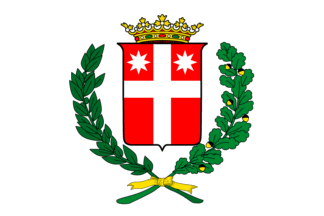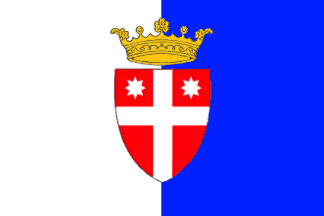
by Arnaud Leroy, 22 May 2004

Last modified: 2021-08-24 by rob raeside
Keywords: veneto | veneto | treviso |
Links: FOTW homepage |
search |
disclaimer and copyright |
write us |
mirrors
See also:
Treviso (82,450 inhabitants) is a provincial capital city in
Venetia, located some 20 kms north of Venice. Some historical
information on Treviso is available on the municipal website <www.comune.treviso.it>.
Here is my rendition from Italian, with some historical details
added for the sake of clarity:
The name of Treviso might come from Celtic Tarvos, meaning
"toro" (?) and the Latin suffix -isium, or from the
name of a tribe of Illyrian origin. During the Age of Iron (Xth
century BP), the local populations were replaced by Venetians
tribes which developed the so-called paleovenetian civilization.
Treviso became a Roman city in 49 BP. After the fall of the
Western Roman Empire in the Vth century, Treviso was incorporated
into the Ostrogothic domain ruled by Theodoric the Great
(454-526, king in 493), who set up his capital in Ravenna, c. 100
km south of Treviso. In May 1164, emperor Frederic Barbarossa
(1122-1190, emperor in 1155) granted municipal autonomy to the
city of Treviso. Between 1283 and 1312, the city was ruled by the
Guelph party, the supporters of the pope, opposed to the
Ghibellines, the supporters of the German emperor. From 1329 to
1388, the Trevisian March was submitted to political instability
and often trashed. The Scaligeri (a.k.a. della Scala), from the
Ghibelline party and lords of Verona, controlled the area from
1329 to 1339. They were succeded by the Venitians from 1339 to
1381, by the duke of Austria from 1381 to 1384, and by the lords
of Carrara until 1388.
After the fall of the Byzantine Empire in 1453, Venice controlled
the eastern Mediterranean Sea, which opened a prosperous period
for Treviso. The city was increased and restructured in the
XIIIth-XIVth centuries. In 1509, Venice decided to make of
Treviso a fortified city to protect itself against the League of
Cambrai. The League was an alliance set up in 1508 by pope Julius
II (Giuliano della Rovere, 1443-1513, pope in 1503), emperor
Maximilian I (1459-1519, emperor in 1508), king of France Louis
XII (1462-1515, king in 1498) and king Ferdinand II the Catholic
(1452-1516, king of Castilie in 1474) and named after the French
city of Cambrai. Louis XII defeated
Venice in Agnadel in 1509 but the coalition dissolved in 1510. In
Treviso, the old city walls and some churches and palaces were
demolished and their stones used to build a new fortification
system. Inside the walls, all buildings in a radius of 800 m were
demolished to increase the efficiency of the defense. The works
were directed by Giovanni of Verona, who also set up a system of
regulation of the level of canals and ditches inside the city.
Treviso was occupied by the French in 1797 and was incorporated
into Austria in 1805, and immediatly then into the Italian
Kingdom set up by Napoleon I. Treviso returned to Austria in
1813. In 1866, Venetia was incorporated to Italy and the city was
restructured. Treviso was severely damaged during the two World
Wars. The bombing of 7 April 1944 caused the death of 2,000 and
the destruction of 80% of the buildings in the city.
On 21 May 2004, the 12th stage of the cyclist "Giro
d'Italia" was run between Cesena and Treviso (216 kms) and
unsurprisingly won by the Italian sprinter Alessandro Petacchi.
The TV reports of cyclist races usually end with nice aerial
views of the arrival city. The images of Treviso distinctly
showed the flag hoisted over the campanile. The flag hoisted
there is white with the municipal arms of Treviso, as they can be
seen on the aforementioned municipal website (greater arms) and
on the International Civic Heraldry
website (shield). The municipal arms of Treviso are red with
a white cross and a white eight-pointed star in the first and
second quarters. On the municipal webiste as well as on the flag,
they are surrounded by two branches, apparently belonging to two
different plants (maybe laurel and oak). On the International
Civic Heraldry website, the stars are show in grey but they seem
to be white on the municipal website and on the real flag.
Ivan Sache, 22 May 2004

by Roberto Breschi from CISV
Based on Vex. It., 1979.
tv-tv.gif)
Greater Coat of Arms
from the municipal
website
tv-tv.jpg)
Lesser Coat of Arms
from the International Civic
Heraldry website